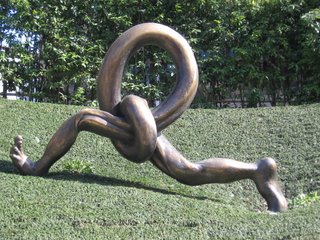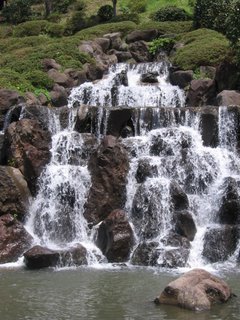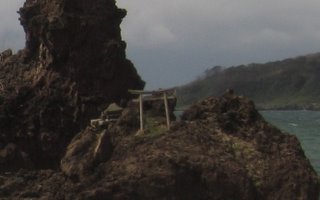Kanazawa, part 1: The Ninja Temple
~Hello again, readers. Today's post concerns my exploration of the city of Kanazawa, a large city three hours by train from Nagaoka. In the feudal age, the domain of Kanazawa was second only to Edo (modern Tokyo) in power and rice production. Luckily, the city was not a military target in WWII, so most of its amazing array of temples and structures survive intact to this day.
 Above: Snowy mountains near the sea, taken on the long train ride to Kanazawa. I actually took about 20 pictures of the mountains because I was bored. I love digital photography.
Above: Snowy mountains near the sea, taken on the long train ride to Kanazawa. I actually took about 20 pictures of the mountains because I was bored. I love digital photography. Above: A broad view of Kanazawa and a one of the several rivers that flow through it. Does anyone know the purpose of that space needle-like structure on the left? My current theory is that it's midget housing.
Above: A broad view of Kanazawa and a one of the several rivers that flow through it. Does anyone know the purpose of that space needle-like structure on the left? My current theory is that it's midget housing.~One of my first stops in Kanazawa was the amazing 'Ninja Temple'. Before you get excited, the Ninja Temple dosen't really have anything to do with ninjas (or so they say); it's actually a Buddhist temple constructed hundreds of years ago by a powerful feudal lord, who wanted a safehouse near Kanazawa Castle.
 Above: Ninja Temple exterior view. There were lots of other gaijin there, some of whom asked for directions.
Above: Ninja Temple exterior view. There were lots of other gaijin there, some of whom asked for directions.~The temple is filled with secret doors, traps, hidden staircases, and seven different levels scattered across four floors. I think it would be so much fun to live there, what with secret stairs hidden in the closets, escape hatches beneath the floorboards, a watchtower at the top, and of course the last resort: a seppuku chamber in the middle. The idea behind all of this is that if enemy soldiers are chasing the lord, he can escape into the temple to confuse them and then sneak out through one of the many hidden exits...or take his own life, if worst came to worst.
 Above: The watchtower atop the Ninja Temple, perfect for spotting approaching armies of samurai intent on decapitating your overlord...and you.
Above: The watchtower atop the Ninja Temple, perfect for spotting approaching armies of samurai intent on decapitating your overlord...and you.~Unforunately, photography was prohibited inside of the Ninja Temple, but do you honestly think I let that stop me? Going into ninja-mode, I was able to grab a couple of pictures for you:
 Above: Remember, the Ninja Temple really is a Buddhist temple. This was the main worship chamber. Naturally, the secondary offering box is actually a spike-filled pit trap.
Above: Remember, the Ninja Temple really is a Buddhist temple. This was the main worship chamber. Naturally, the secondary offering box is actually a spike-filled pit trap.

Above left, a set of stairs with translucent backing. Above right, the view from the secret compartment beneath the stairs, where you can easily see the shadows of people walking down...but they can't see you. Perfect for some unexpected foot-stabbing.
~After the Ninja Temple, I was off to see the castle and gardens of Kanazawa, supposedly one of the three best garden-parks in Japan (one of the others is Okayama, which I previously posted about). On the way, I observed some unusual statuary:
 Above: I actually took two pictures of this little guy, but I liked the one with the flash off; the shadow makes him look more menacing. Or more constipated.
Above: I actually took two pictures of this little guy, but I liked the one with the flash off; the shadow makes him look more menacing. Or more constipated. Above: ...words fail me.
Above: ...words fail me.~Stay tuned for amazing shrines, castle ruins, Japanglish, and a one-man-band! Oyasumi.














































